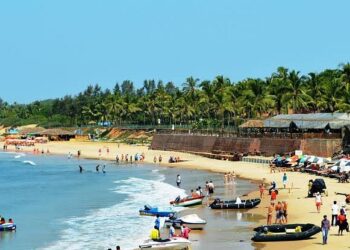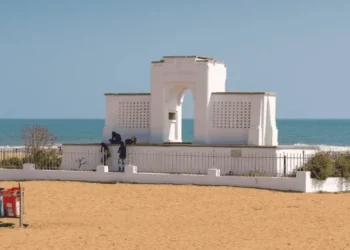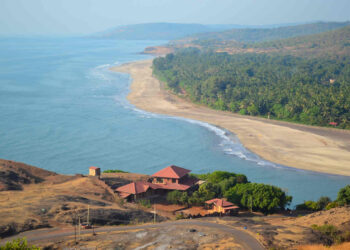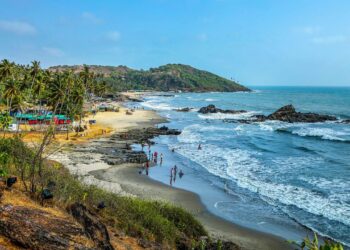Nestled in the heart of Bhuj, Kutch, Gujarat, the Shree Swaminarayan Temple is a holy shrine dedicated to Lord Swaminarayan, founder of the Swaminarayan sect. Built way back in 1823 by Swaminarayan’s followers, this temple is dedicated to the deity Nar Narayan. is the first Temple of the Swaminarayan Sampraday, a Hindu sect. As per the will of Swaminarayan, the administration of the Swaminarayan Sampraday is divided into two Gadis (seats) – NarNarayan Dev Gadi and LaxmiNarayan Dev Gadi. This Temple is the headquarters of the NarNarayan Dev Gadi.
Fun Fact: The temple was rebuilt after the 2001 earthquake, keeping its old look but stronger.
Mythological Importance
Shree Swaminarayan Temple holds deep tales. One story says Lord Swaminarayan, born in 1781, was a form of Vishnu sent to guide folks to a pure life. Swaminarayan Bhagwan incarnated on earth, along with His dham and some of His muktas, to establish ekantik dharma, and grant kalyan to those who became His bhaktas. He incarnated at Dharma-Dev’s house in Chhapaiya in Kaushal-Desh, to save Bhakti-Mata and Dharma-Dev from harassment by demons. He also incarnated to take mumukshu bhaktas to Akshardham, by imparting knowledge of His svarup, dharma, vairagya, and bhakti.
While on earth, He established ekantik dharma, which had been destroyed many years ago, and He destroyed adharma. He initiated over 2000 sadhus, of which 500 were initiated as paramhans. Also, He built mandirs, and installed murtis, which will always remain on earth. In this way, Bhagwan forever resides on this earth through His sadhus and His murtis. Swaminarayan Bhagwan also wrote and narrated shastras, authenticated ancient shastras, and instructed His sadhus to write shastras.Another tale tells of him visiting Bhuj, blessing the land after a drought, and his followers built this shrine. Locals think praying here brings peace and strength. As a main Swaminarayan site, it’s tied to his teachings of devotion and good deeds.
Historical Overview
The temple was built in 1823 by Swaminarayan’s disciples, when Kutch was a trade hub. This mandir comes under the Narnarayan Dev Gadi. Senior devotees Gangarambhai jethi Sundarjibhai, Jigneshwarbhai and others from the Bhuj region of Kutch went to Gadhada where God Swaminarayan was attending a Fuldol festival. In that festival, the devotees of Bhuj met Swaminarayan and requested him to construct a temple in Bhuj. God Swaminarayan asked Vaishnavananand Swami to proceed with a team of the saints to Bhuj and construct a temple. Vaishnavanand Swami and the accompanying saints went to Bhuj in 1822, camped at the place neighbouring the land of temple drew plans of the temple, complex, executed the plans with minute details and within a short span of one year, they built a temple abode of NarNarayan Dev. Bhuj’s ruler, Rao Deshalji II, gave land for it. A stone from 1823 marks its start. In the 1900s, it grew as a pilgrimage spot. The 2001 earthquake hit it hard, but the Swaminarayan Sampraday rebuilt it by 2003, keeping the old style. After 1947, the Bhuj Swaminarayan Trust took over. Fixes in the 2010s kept its charm. Saints like Swaminarayan spread its name through sermons. Now, many visit Bhuj’s holy ground. The temple’s past is full. Old sect records from the 1800s talk of its glory. British notes from then call it fine. Photos from 1900 show its early look.
Architecture of Shree Swaminarayan Temple
Shree Swaminarayan Temple sits on 3 acres in Bhuj’s center, built in Swaminarayan style. The main shrine, from 1823, has a colorful dome with carvings of Swaminarayan seated, lotus blooms, and peacocks, all in wood and plaster. Inside, there’s a 2-foot idol of Swaminarayan, gold-plated, sitting calm, lit by soft lamps. The inner walls have painted scenes of his life.
The temple has a sabha mandapa with 16 wooden pillars, carved with flowers and gods. Small shrines for Radha-Krishna, Hanuman, and Ganesh are in the yard, made of stone. The Radha-Krishna one shows them with flutes, for love. The Hanuman one, from 1850, has him kneeling, for strength. The Ganesh one shows him seated, for wisdom. The grounds, with tiled floors, feel holy, near Bhuj’s lake. A gate with carved arches welcomes all. A water tank for rituals has plain steps. Pillars tell Swaminarayan’s tales, guiding those who come. The bright colors shine.
Rituals and Festivals
The temple wakes up when festivals come. Diwali, in October or November, is grand, with lamps and Annakut food offerings. Swaminarayan Jayanti, in April, marks his birth with bhajans. Janmashtami, in August, honors Krishna with dances. Holi, in March, brings colors and songs. Guru Purnima, in July, thanks swamis with prayers.
Information for Visitors
Hours and Entry: Open every day, 6:00 AM to 7:00 PM. It’s free to go in, but prayers cost ₹100-300. No pictures in the inner room.
Clothing: Wear clothes that cover shoulders and knees. Women for prayers wear sarees or suits, men wear kurtas.
How to Get There:
Air: Bhuj Airport, 5 km away, is closest. Taxis take 15 minutes to the temple.
Train: Bhuj Station, 3 km away, links to Ahmedabad (7 hours).
Road: Buses from Gandhidham (1 hour) come to Bhuj.
Best Time to Visit: October to March is cool, 20-30°C. Weekdays are quiet. Diwali’s busy, so plan early.
Nearby Attractions:
Dattatreya Temple, 15 km away, is a hill shrine.
Hamirsar Lake, 1 km away, is a calm spot.
Great Rann of Kutch, 80 km away, is a salt desert.
Shyamji Krishna Varma Memorial, 5 km away, honors a hero.
Mandvi Beach, 60 km away, is a sea spot.
Final Thoughts
Shree Swaminarayan Temple in Bhuj, Gujarat, a holy spot in western India, is a treasure for the heart. Lord Swaminarayan’s pure touch reaches all who come, making it a place you must see among India’s sacred spots.











